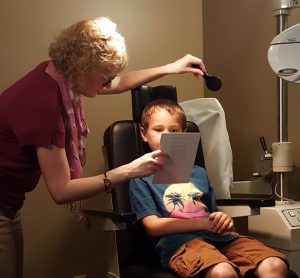15 Warning Signs Your Child May Have a Vision Problem
If your child is struggling at school, a vision problem may be to blame.
Children with undetected vision problems are sometimes diagnosed with learning disabilities including ADD or ADHD. While many schools conduct basic eye screenings, these are not a substitute for a thorough eye exam by an optometrist.
The AOA recommends exams at six months, three years, before first grade, and every two years thereafter until age 18.
 15 Warning Signs Your Child Might Have a Vision Problem
15 Warning Signs Your Child Might Have a Vision Problem
The following is a list of the most common warning signs seen in children with some type of vision disorder:
- Squinting – Squinting can be a sign of compensating for poor vision.
- Tilting Head – Tilting one’s head when reading can be a sign of muscle imbalance (strabismus) in the eyes.
- Sitting Too Close – If your child prefers to sit close to the TV, it could be a sign of nearsightedness.
- Loses Place When Reading – Skipping lines or losing place while reading can indicate a tracking problem or astigmatism.
- Covers or Shuts One Eye – Covering or shutting one eye can indicate a vision problem in one or both eyes.
- Rubbing Eyes – This is a sign of eye fatigue. If their eyes are getting tired, there could be a vision problem.
- Crossed or “Lazy Eye” – Eyes that do not work together can affect your child’s ability to read. Eyes need to work as a team.
- Frequent Headaches – Does your child complain of frontal headaches? The cause could be your child attempting to compensate for blurry vision.
- Sensitivity to Light – Sensitivity to light is a sign of exotropia (a type of strabismus).
- Easily Distracted – If your child is easily distracted in the classroom or has a difficult time paying attention, it could be a sign that your child cannot see their work and are therefore getting restless.
- Dislikes Reading – If your child dislikes reading or tries to avoid it all costs, it could indicate that reading is difficult due to a vision disorder.
- Low Comprehension – Do you think your child understands what he reads? Is he able to retrieve and remember what he has learned at school or just read?
- Errors When Copying – Have you noticed that your child makes many errors when copying from one page to another?
- Frequently Misses Small Words – If your child tends to skip smaller words when reading aloud (at, is, or, the, etc.), she may have a tracking problem.
- Prefers to Write Vertically – When writing solo, does your child prefer to write vertically (up and down) versus horizontally (across the page)?
Any of the last few items in the list could be a warning sign of a vision disorder or even a learning or reading disability. Having a comprehensive eye exam with a skilled optometrist can help to determine where the problem lies.
If you notice any of these symptoms or warning signs, contact Eye Care Associates or your local optometrist and schedule a comprehensive eye exam for your child.